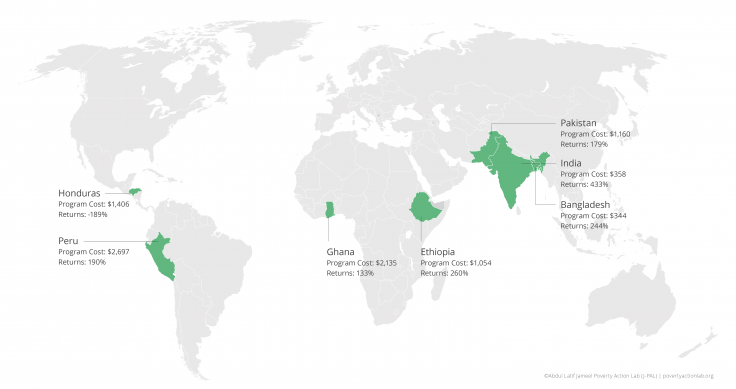Graduating the Ultra-Poor in Pakistan
- Rural population
- Earnings and income
- Employment
- Empowerment
- Self-employment
- Women’s/girls’ decision-making
- Mental health
- Graduation approach
More than one-fifth of the world’s population lives on less than US$1.25 per day. While many credit and training programs have not been successful at raising income levels for these ultra-poor households, recent support for livelihoods programs has spurred interest in evaluating whether comprehensive “big push” interventions may allow for a sustainable transition to self-employment and a higher standard of living. To test this theory, in six countries researchers evaluated a multi-faceted approach aimed at improving the long-term income of the ultra-poor. They found that the approach had long-lasting economic and self-employment impacts and that the long-run benefits, measured in terms of household expenditures, outweighed their up-front costs. This evaluation summarizes the Pakistan site, which had similar effects as the other successful sites.
Policy issue
More than a billion people live on less than US$1.25 per day . Many of these families depend on insecure and fragile livelihoods, including casual farm and domestic labor. Their income is frequently irregular or seasonal, putting laborers and their families at risk of hunger. Self-employment is often the only viable alternative to menial labor for the ultra poor, yet many lack the necessary cash or skills to start a business that could earn more than casual labor.
In the past, many programs that have provided poor households with either credit or training to alleviate these constraints have not been successful at raising household income levels on average. However, in recent years, several international and local nongovernmental organizations have renewed their support for programs that foster a transition to more secure livelihoods. Combining complementary approaches—the transfer of a productive asset, training, consumption support, and coaching—into one comprehensive program may help spur a sustainable transition to self-employment. To better understand the effect of these programs on the lives of the ultra-poor, researchers conducted six randomized evaluations in Ethiopia, Ghana, Honduras, India, Pakistan, and Peru.
Context of the evaluation
This study took place in the Coastal Sindh region of Pakistan. To implement the Graduation program, researchers partnered with Aga Khan Planning and Building Services Pakistan, Badin Rural Development Society, Indus Earth Trust, and Sindh Agricultural and Forestry Workers Coordinating Organization, who jointly implemented the Graduation program under the leadership and funding of Pakistan Poverty Alleviation Fund. To select the poorest members of the communities, the project team conducted a Participatory Wealth Ranking, in which villagers collectively ranked households according to their wealth during a community meeting. The ranking process was followed by a short survey to verify the results.
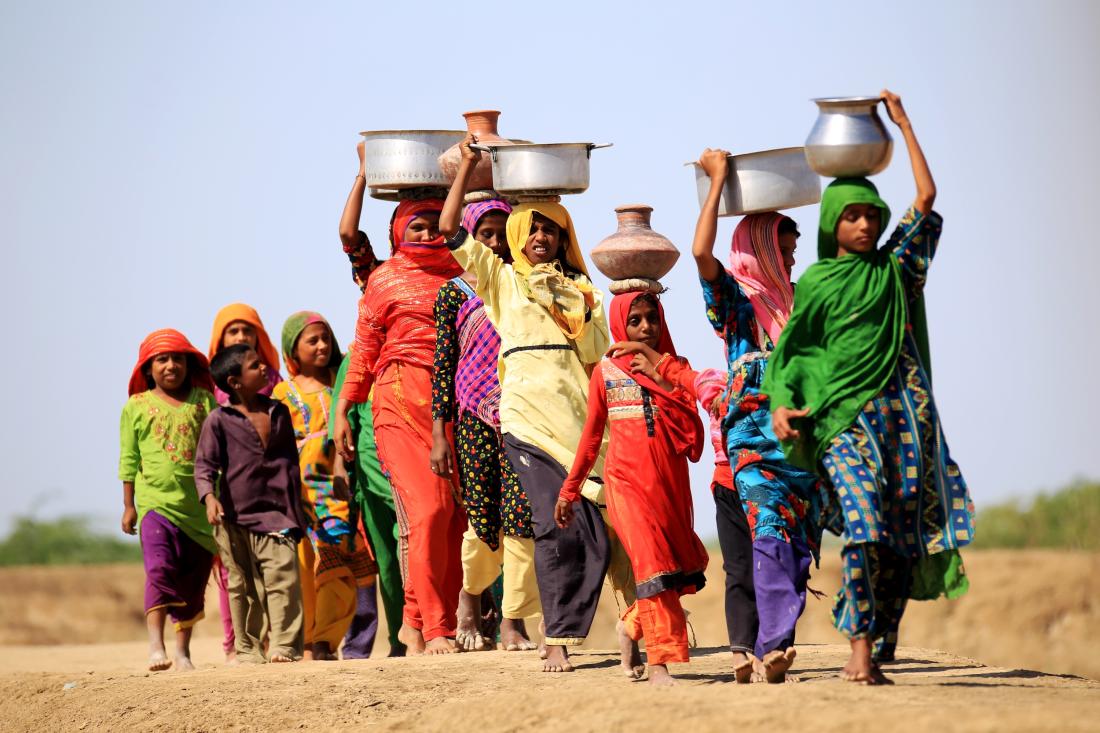
Details of the intervention
Researchers conducted a randomized evaluation to test the impact of a two-year comprehensive livelihoods program (“the Graduation approach”) on the lives of the ultra-poor in Pakistan. The approach was first developed by the Bangladeshi NGO BRAC in 2002 and has since been replicated in several countries. From a sample of 1,299 households, researchers randomly assigned half to the treatment group, and half to the comparison group, which was not eligible to receive the program.
The Graduation program consisted of six complementary components, each designed to address specific constraints facing ultra-poor households.
-
Productive asset transfer: One-time transfer of a productive asset valued at 15,000 Pakistan rupees (2014 PPP US$1043.33). More than half of the households picked goats as their asset, while 11 percent chose to open shops, and 10 percent picked hens.
-
Technical skills training: Training on running a business and managing their chosen livelihood. For example, households who selected livestock were taught how to rear the livestock, including vaccinations, feed, and treatment of diseases.
-
Consumption support: Monthly cash transfers of 1,000 Pakistan rupees (2014 PPP US$69.56) for the first year in the program.
-
Health: Female health visitors provided basic health services including checkups, health and hygiene training, and medicine. More difficult and serious cases were referred to the nearest doctor.
-
Savings account: Encouragement to save money at home, in boxes, or with Rotating Savings and Credit Associations (ROSCAs)
-
Household visits: Weekly visits by local NGO staff for 24 months to provide accountability, coaching, and encouragement. In some cases, these visits were reduced to a bi-weekly or monthly basis.
Researchers conducted the first endline survey immediately after the two-year program ended, as well as a second endline survey approximately twelve months later, a year after all program activities ended.
Results and policy lessons
Across all six countries, researchers found that the program caused broad and lasting economic impacts. Treatment group households consumed more, had more assets, and increased savings. The program also increased basic entrepreneurial activities, which enabled the poor to work more evenly across the year. While psychosocial well-being improved, these noneconomic impacts sometimes faded over time. In five of the six studies, long-run benefits outweighed their up-front costs. In Pakistan, households that received the Graduation program experienced positive impacts in most areas:
Economic impacts: Average total monthly consumption among treatment households was 2014 PPP US$91.08, a 7 percent increase compared to the comparison group, while food consumption did not increase significantly.
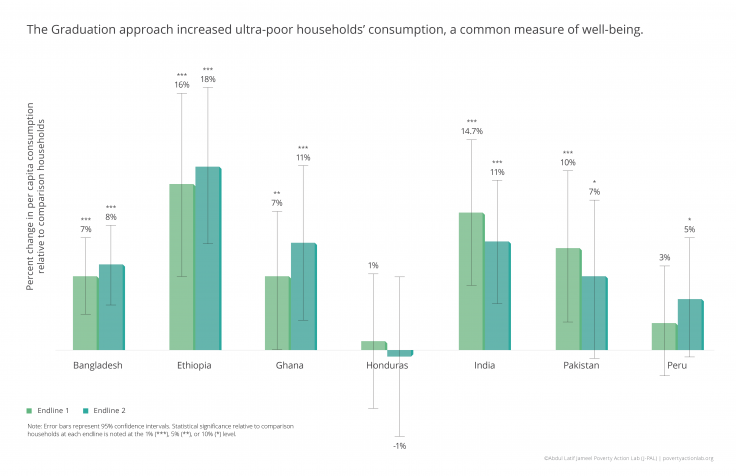
Households saw a 29 percent increase in the value of their total assets on average (valued, on average, at 2014 PPP US$1,188 as compared to comparison households’ average asset value of 2014 PPP US$918.00). Unlike in any of the other countries, in Pakistan households in the program borrowed significantly less than households in the comparison group.
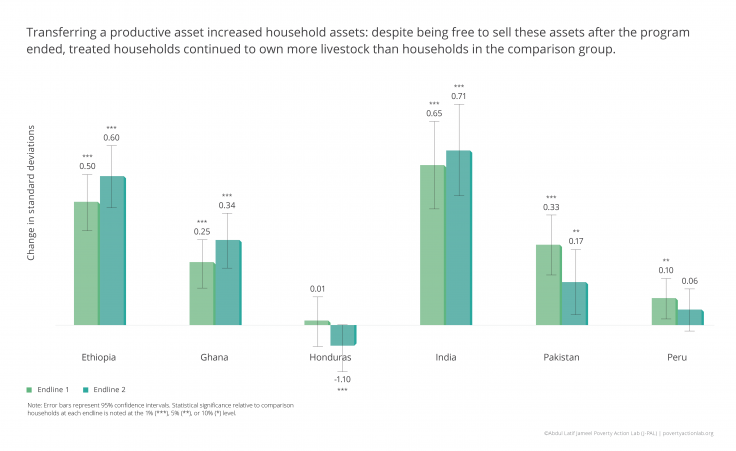
Self-employment: Households experienced a 62 percent increase in revenue from livestock (to 2014 PPP US$70.50 a month) on average, but they did not experience significant gains in agricultural income or non-farm income, nor did they report any significant changes in how they allocated their time.
Psychosocial wellbeing: Households that participated in the program did not report feeling significantly happier or in any better health than those who did not participate.
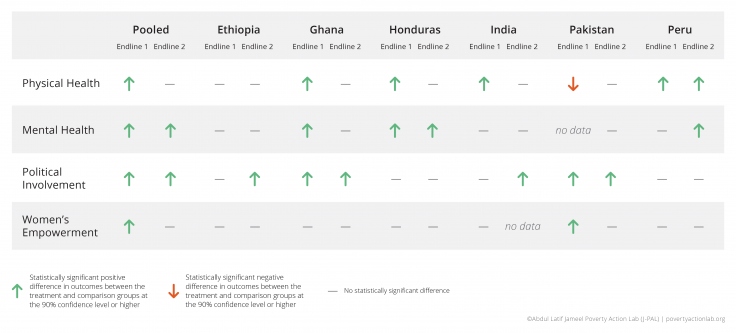
Political involvement: Political involvement increased by one measure among participants in Pakistan; they were 31 percent more likely to be a member of a political party one year after the program ended. Women in treatment households did not experience any significant, lasting gains in empowerment.
Cost-benefit analysis: Compared to less comprehensive interventions, the Graduation program had relatively high up-front costs. Researchers calculated total implementation and program costs to be US$864 per household in Pakistan (2014 PPP US$5,962). However, estimated benefits from consumption and assets growth amount to 2014 PPP US$10,678 per household, representing an overall 179 percent return.
